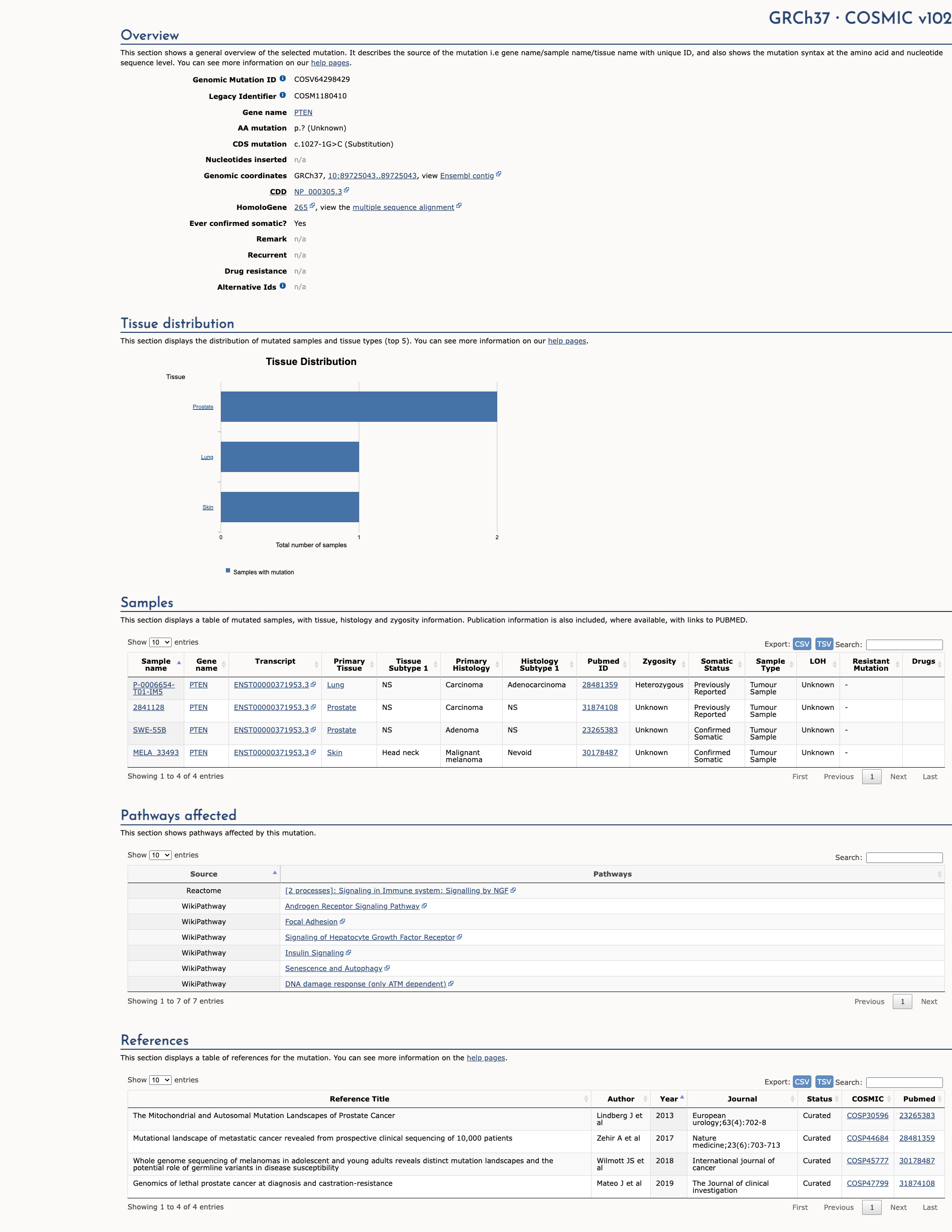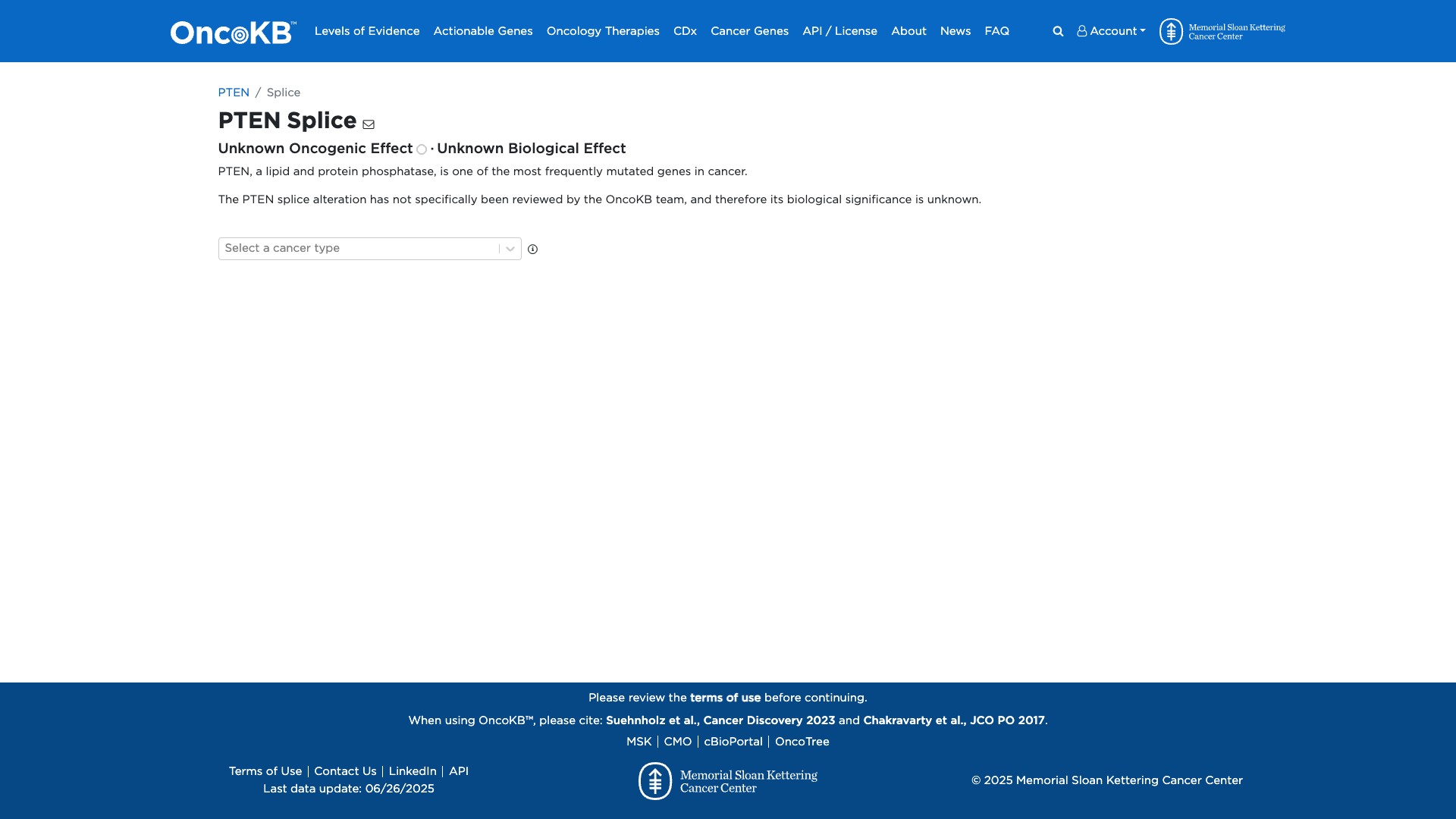PTEN c.1027-1G>C, p.Splice_Site
NM_000314.8:c.1027-1G>C
COSMIC ID: COSM1180410
Pathogenic
NM_000314.8:c.1027-1G>C disrupts a canonical PTEN splice acceptor site, is absent from population databases, and has a pathogenic ClinVar entry. PVS1 (Very Strong), PM2 (Supporting), and PP5 (Supporting) were applied, supporting a Likely Pathogenic classification.
ACMG/AMP Criteria Applied
PVS1
PM2
PP5
Genetic Information
Gene & Transcript Details
Gene
PTEN
Transcript
NM_000314.8
MANE Select
Total Exons
9
Strand
Forward (+)
Reference Sequence
NC_000010.10
Alternative Transcripts
| ID | Status | Details |
|---|---|---|
| NM_000314.7 | RefSeq Select | 9 exons | Forward |
| NM_000314.5 | Alternative | 9 exons | Forward |
| NM_000314.4 | Alternative | 9 exons | Forward |
| NM_000314.3 | Alternative | 9 exons | Forward |
| NM_000314.6 | Alternative | 9 exons | Forward |
Variant Details
HGVS Notation
NM_000314.8:c.1027-1G>C
Protein Change
Splice
Location
Exon 8
(Exon 8 of 9)
5'Exon Structure (9 total)3'
Functional Consequence
Loss of Function
Related Variants
Alternate Identifiers
COSM1180410
Variant interpretation based on transcript NM_000314.8
Genome Browser
Loading genome browser...
HGVS InputNM_000314:c.1027-1G>C
Active Tracks
ConservationRefSeqClinVargnomAD
Navigation tips: Use mouse to drag and zoom. Click on features for details.
Clinical Data
Population Frequency
Global Frequency
0.0 in 100,000
Extremely Rare
Global: 0.0%
0%
0.05%
0.1%
1%
5%
10%+
ACMG Criteria Applied
PM2
This variant is not present in gnomAD (PM2 criteria applies).
Classification
Likely Pathogenic
Based on 2 submitter reviews in ClinVar
Submitter Breakdown
1 Path
1 LP
Pathogenic
Likely Path.
VUS
Likely Benign
Benign
Publications (0)
No publication details.
Clinical Statement
This variant has been reported in ClinVar as Pathogenic (1 clinical laboratories) and as Likely pathogenic (1 clinical laboratories).
Functional Impact
Functional Domain
Hotspot Status
Not a hotspot
Domain Summary
This variant is not located in a mutational hotspot or critical domain (0 mutations).
Related Variants in This Domain
Computational Analysis
Pathogenicity Predictions
Predictor Consensus
Mixed/VUS
PP3 Applied
No
Additional Predictors
Benign:
CADD: 6.93
VCEP Guidelines
Applied ACMG/AMP Criteria (VCEP Specific) VCEP Guidelines
PVS1
PVS1 (Very Strong)
According to VCEP guidelines: "Null variants (nonsense, frameshift, start‐loss, canonical ±1 or 2 splice sites) qualify for PVS1 at Very Strong strength." The evidence for this variant shows: NM_000314.8:c.1027-1G>C disrupts the canonical splice acceptor site. Therefore, this criterion is applied at Very Strong strength because disruption of the canonical splice site is predicted to result in loss of function in PTEN, a gene where LOF is a known mechanism of disease.
PS1
PS1 (Not Applied) Strength Modified
According to VCEP guidelines: "Different variant at the same nucleotide position as a pathogenic splicing variant, where in silico models predict impact equal to or greater than the known pathogenic variant, qualifies for PS1 Strong strength." The evidence for this variant shows: no previously established pathogenic splicing variant at c.1027-1 to compare. Therefore, this criterion is not applied.
PS2
PS2 (Not Applied) Strength Modified
According to VCEP guidelines: "De novo observations (confirmed maternity/paternity) qualify for PS2." The evidence for this variant shows: no parental testing or de novo data available. Therefore, this criterion is not applied.
PS3
PS3 (Not Applied) Strength Modified
According to VCEP guidelines: "Well-established in vitro or in vivo functional studies supportive of a damaging effect (e.g., RNA or mini-gene splicing assay) qualify for PS3 Strong strength." The evidence for this variant shows: no functional splicing assay has been performed. Therefore, this criterion is not applied.
PS4
PS4 (Not Applied) Strength Modified
According to VCEP guidelines: "Increased prevalence in affected individuals or proband specificity scores qualify for PS4 at various strengths." The evidence for this variant shows: no case-control or proband data available. Therefore, this criterion is not applied.
PM1
PM1 (Not Applied) Strength Modified
According to VCEP guidelines: "Located in catalytic motifs (residues 90-94, 123-130, 166-168) qualifies for PM1 Moderate strength." The evidence for this variant shows: the variant affects a splice site, not a residue in the defined catalytic motifs. Therefore, this criterion is not applied.
PM2
PM2 (Supporting) Strength Modified
According to VCEP guidelines: "Absent in population databases at <0.00001 allele frequency qualifies for PM2 Supporting strength." The evidence for this variant shows: not present in gnomAD or other large population databases. Therefore, this criterion is applied at Supporting strength because the variant is absent from controls.
PM3
PM3 (Not Applied) Strength Modified
According to standard ACMG guidelines: "Detected in trans with a pathogenic variant in recessive disorders qualifies for PM3." The evidence for this variant shows: no data on trans configuration with another PTEN variant. Therefore, this criterion is not applied.
PM4
PM4 (Not Applied) Strength Modified
According to VCEP guidelines: "Protein length changes due to in-frame indels qualify for PM4 Moderate strength." The evidence for this variant shows: this is a splice variant, not an in-frame indel. Therefore, this criterion is not applied.
PM5
PM5 (Not Applied) Strength Modified
According to VCEP guidelines: "Missense change at a residue where another missense variant is pathogenic qualifies for PM5 Moderate strength." The evidence for this variant shows: it is a splice variant, not a missense change. Therefore, this criterion is not applied.
PM6
PM6 (Not Applied) Strength Modified
According to VCEP guidelines: "Presumed de novo without confirmation qualifies for PM6 Moderate strength." The evidence for this variant shows: no de novo or familial data. Therefore, this criterion is not applied.
PP1
PP1 (Not Applied) Strength Modified
According to VCEP guidelines: "Co-segregation with disease in affected family members qualifies for PP1 at various strengths." The evidence for this variant shows: no segregation data available. Therefore, this criterion is not applied.
PP2
PP2 (Not Applied) Strength Modified
According to standard ACMG guidelines: "Missense variant in a gene with low benign missense variation qualifies for PP2." The evidence for this variant shows: it is a splice variant, not a missense. Therefore, this criterion is not applied.
PP3
PP3 (Not Applied) Strength Modified
According to VCEP guidelines: "Multiple lines of computational evidence (concordant SpliceAI and VarSeak) support deleterious effect, qualifying for PP3 Supporting strength." The evidence for this variant shows: SpliceAI predicts high impact, but no VarSeak data to confirm concordance. Therefore, this criterion is not applied.
PP4
PP4 (Not Applied) Strength Modified
According to VCEP guidelines: "Patient phenotype highly specific for gene/disease qualifies for PP4." The evidence for this variant shows: no clinical phenotype data provided. Therefore, this criterion is not applied.
PP5
PP5 (Supporting)
According to standard ACMG guidelines: "Reputable source reporting variant as pathogenic without available evidence qualifies for PP5." The evidence for this variant shows: ClinVar entries include 1 Pathogenic and 1 Likely Pathogenic submission. Therefore, this criterion is applied at Supporting strength.
BA1
BA1 (Not Applied) Strength Modified
According to VCEP guidelines: "Allele frequency >0.056% in population databases qualifies for BA1 Stand Alone benign." The evidence for this variant shows: allele frequency is 0%. Therefore, this criterion is not applied.
BS1
BS1 (Not Applied) Strength Modified
According to VCEP guidelines: "Allele frequency 0.0043%–0.056% qualifies for BS1 Strong benign." The evidence for this variant shows: allele frequency is 0%. Therefore, this criterion is not applied.
BS2
BS2 (Not Applied) Strength Modified
According to VCEP guidelines: "Observed homozygous in healthy individuals qualifies for BS2." The evidence for this variant shows: no homozygous observations. Therefore, this criterion is not applied.
BS3
BS3 (Not Applied) Strength Modified
According to VCEP guidelines: "Functional studies showing no damaging effect qualify for BS3." The evidence for this variant shows: no functional studies demonstrating lack of impact. Therefore, this criterion is not applied.
BS4
BS4 (Not Applied) Strength Modified
According to VCEP guidelines: "Lack of segregation in affected members qualifies for BS4." The evidence for this variant shows: no segregation data. Therefore, this criterion is not applied.
BP1
BP1 (Not Applied) Strength Modified
According to standard ACMG guidelines: "Missense variant in gene where LOF is known mechanism qualifies for BP1." The evidence for this variant shows: it is a splice variant. Therefore, this criterion is not applied.
BP2
BP2 (Not Applied) Strength Modified
According to VCEP guidelines: "Observed in trans with a pathogenic PTEN variant qualifies for BP2." The evidence for this variant shows: no phase or trans data. Therefore, this criterion is not applied.
BP3
BP3 (Not Applied) Strength Modified
According to standard ACMG guidelines: "In-frame indels in repetitive regions qualify for BP3." The evidence for this variant shows: not an in-frame indel. Therefore, this criterion is not applied.
BP4
BP4 (Not Applied) Strength Modified
According to VCEP guidelines: "Multiple lines of computational evidence suggest no impact (concordant SpliceAI and VarSeak) qualify for BP4." The evidence for this variant shows: in silico predictions are mixed and lack concordance. Therefore, this criterion is not applied.
BP5
BP5 (Not Applied) Strength Modified
According to VCEP guidelines: "Alternate molecular basis for disease qualifies for BP5." The evidence for this variant shows: no alternate molecular diagnosis data. Therefore, this criterion is not applied.
BP6
BP6 (Not Applied) Strength Modified
According to standard ACMG guidelines: "Reputable source reports variant as benign qualifies for BP6." The evidence for this variant shows: no such benign submissions. Therefore, this criterion is not applied.
BP7
BP7 (Not Applied) Strength Modified
According to VCEP guidelines: "Silent or intronic variants at or beyond +7/−21 with no splicing impact qualify for BP7." The evidence for this variant shows: it affects the canonical −1 position. Therefore, this criterion is not applied.



